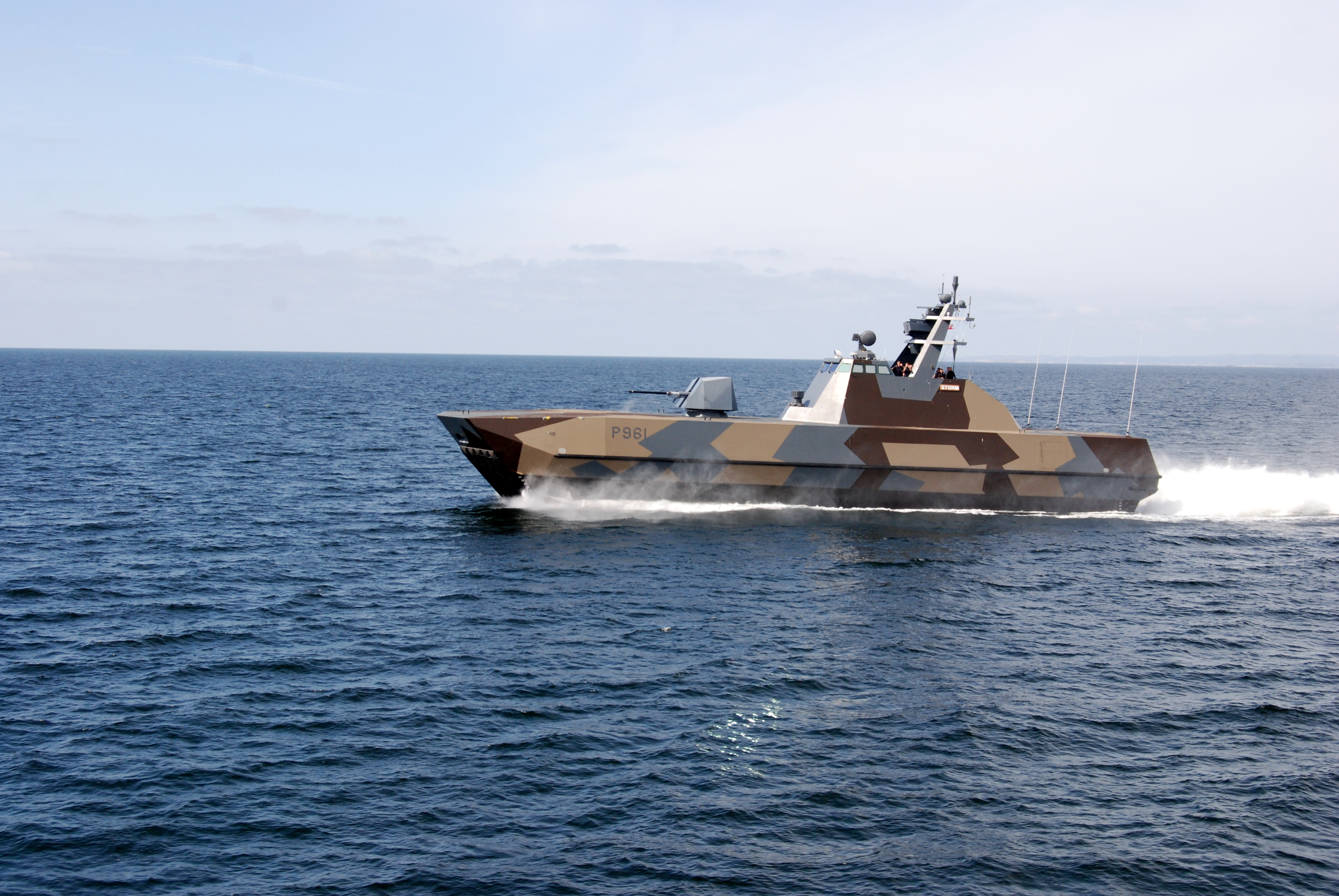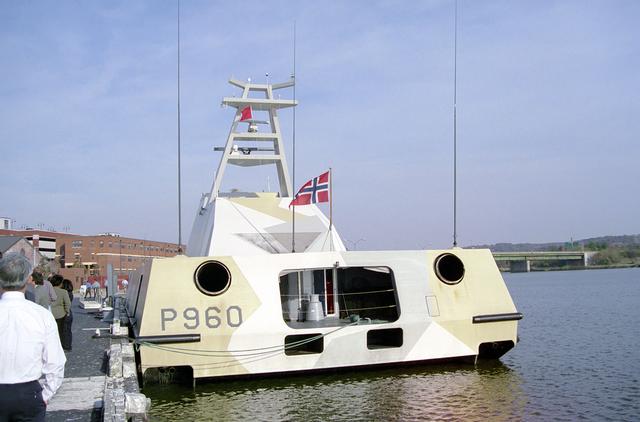Skjold-class patrol boat on:
[Wikipedia]
[Google]
[Amazon]
''Skjold''-class corvettes (skjold means "shield" in Norwegian) are a class of six light, superfast, stealth missile
 The final design was changed compared to the prototype ''Skjold'', which itself was rebuilt to the new specifications. Most notably, the vessels use 4
The final design was changed compared to the prototype ''Skjold'', which itself was rebuilt to the new specifications. Most notably, the vessels use 4

 The U.S. Navy and Coast Guard expressed interest in the design and leased the P960 for a period of one year, from 2001 until 2002. During that time it was operated by a 14-man Norwegian crew out of Naval Amphibious Base Little Creek.
The U.S. Navy and Coast Guard expressed interest in the design and leased the P960 for a period of one year, from 2001 until 2002. During that time it was operated by a 14-man Norwegian crew out of Naval Amphibious Base Little Creek.
''Performance characteristics of a 260t displacement SES''
Dept. Applied Mathematics Report, The University of Adelaide, 19 February 2008.
''Norwegian Skjold class corvettes storm and steil in Plymouth Sound''
9 July 2015. {{DEFAULTSORT:Skjold Class Patrol Boat Missile boats of the Royal Norwegian Navy Patrol vessels of Norway Military catamarans Stealth ships Corvette classes Patrol boat classes
corvette
A corvette is a small warship. It is traditionally the smallest class of vessel considered to be a proper (or " rated") warship. The warship class above the corvette is that of the frigate, while the class below was historically that of the slo ...
s in service with the Royal Norwegian Navy
The Royal Norwegian Navy ( no, Sjøforsvaret, , Sea defence) is the branch of the Norwegian Armed Forces responsible for naval operations of Norway. , the Royal Norwegian Navy consists of approximately 3,700 personnel (9,450 in mobilized state, 3 ...
. The boats were formerly classed as MTBs ( motor torpedo boats) but, from 2009, the Royal Norwegian Navy has described them as corvettes (''korvett'') because their seaworthiness is seen as comparable to corvettes, and because they do not carry torpedoes. They were built at the Umoe Mandal
Umoe Mandal AS is a shipbuilding company in the Ulltveit-Moe Group. Their shipyards are based at Mandal in Norway.
Founded in 1989 as Kværner Båtservice, later Kværner Mandal, and known as Umoe Mandal since 2000, the company specialises in hig ...
yard. With a maximum speed of , the ''Skjold''-class corvettes were the fastest combat ships afloat at the time of their introduction.
Development and production
The ''Skjold''-class vessels began with the development of the Royal Norwegian Navy's "Project SMP 6081", and the first preproduction version was ordered on 30 August 1996. The first ship of its class, P960, was launched on 22 September 1998 and commissioned 17 April 1999. A Norwegian Parliamentary White Paper of 2001 recommended building five additional boats, and this was agreed to in 2002. Six ''Skjold''-class vessels replaced the Royal Norwegian Navy's previous fourteen s.Design
The ''Skjold'' design is a surface effect craft, constructed ofglass fibre
Glass fiber ( or glass fibre) is a material consisting of numerous extremely fine fibers of glass.
Glassmakers throughout history have experimented with glass fibers, but mass manufacture of glass fiber was only made possible with the inventio ...
/carbon composite materials. Buoyancy is augmented underway by a fan-blown skirted compartment between the two rigid catamaran-type hulls. This provides an alternative solution to the planing hull/vee hull compromise: the air cushion reduces wave slam at high speeds while presenting a low-drag flat planing profile at the waterline.
To ensure stealth capabilities, anechoic
An anechoic chamber (''an-echoic'' meaning "non-reflective") is a room designed to stop reflections of either sound or electromagnetic waves. They are also often isolated from energy entering from their surroundings. This combination means t ...
coatings of radar absorbent material
In materials science, radiation-absorbent material, usually known as RAM, is a material which has been specially designed and shaped to absorb incident RF radiation (also known as non-ionising radiation), as effectively as possible, from as m ...
s (RAM) have been used in the load-bearing structures over large areas of the ship. This strategy leads to significant weight saving compared to the conventional construction technique of applying RAM cladding to the external surfaces. The ship's profile has a faceted appearance with no right angle structures and few orientations of reflective panels. Doors and hatches are flush with the surfaces and the windows are flush without visible coaming
Coaming is any vertical surface on a ship designed to deflect or prevent entry of water. It usually consists of a raised section of deck plating around an opening, such as a cargo hatch. Coamings also provide a frame onto which to fit a hatch cove ...
(edge of window aperture) and are fitted with radar reflective screens. The vessels are additionally protected by the Rheinmetall MASS sensor / decoy system.
 The final design was changed compared to the prototype ''Skjold'', which itself was rebuilt to the new specifications. Most notably, the vessels use 4
The final design was changed compared to the prototype ''Skjold'', which itself was rebuilt to the new specifications. Most notably, the vessels use 4 gas turbines
A gas turbine, also called a combustion turbine, is a type of continuous flow internal combustion engine. The main parts common to all gas turbine engines form the power-producing part (known as the gas generator or core) and are, in the directi ...
combined by Renk COGAG
Combined gas turbine and gas turbine (COGAG) is a type of propulsion system for ships using two gas turbines connected to a single propeller shaft. A gearbox and clutches allow either of the turbines to drive the shaft or both of them combined.
...
gear units built in a lightweight design. The smaller gas turbines rated 2,000 kW turbines are used for cruising speed. For sprint speed a second, larger gas turbine is combined providing a total of 6,000 kW to the waterjet on each shaft line. Two MTU 123 cruise diesel propulsion units used previously at loiter speeds were removed. The foredeck was strengthened to accommodate the addition of a 76 mm Otobreda Super Rapid gun.
The hull material was produced by a different method to improve strength and minimize vulnerability to fire. The bridge saw some changes, including an upgrade to six weapon systems control consoles.
In 2020, the Norwegian Government decided to further upgrade the Skjold-class vessels, partially to compensate for the loss of the frigate Helge Ingstad. The upgrades would take place between 2020 and 2024, permitting the Skjold-class to remain up-to-date through to 2030 when replacement vessels were envisaged under terms of the Government's defence plan.
US Navy

 The U.S. Navy and Coast Guard expressed interest in the design and leased the P960 for a period of one year, from 2001 until 2002. During that time it was operated by a 14-man Norwegian crew out of Naval Amphibious Base Little Creek.
The U.S. Navy and Coast Guard expressed interest in the design and leased the P960 for a period of one year, from 2001 until 2002. During that time it was operated by a 14-man Norwegian crew out of Naval Amphibious Base Little Creek.
Vessels
See also
*List of ships of the Norwegian Navy
This article is a list of Royal Norwegian Navy fleet units and vessels, both past and present.
Ships from the years 1509 to 1814 might be listed under Royal Dano-Norwegian Navy.
Fleet units and vessels (present)
Frigates
*
** Mo, Sver ...
Similar ships
* (United Arab Emirates) * (Finland) * Steregushchiy-class corvette (Russia) * Type 022 missile boat (People’s Republic of China) * Milgem-class corvette (Turkey) * (Greece) * (Sweden) * (Republic of China)References
* Saunders, Stephen "Jane's Fighting Ships 2003–2004" .External links
* Leo Lazauskas (2008''Performance characteristics of a 260t displacement SES''
Dept. Applied Mathematics Report, The University of Adelaide, 19 February 2008.
''Norwegian Skjold class corvettes storm and steil in Plymouth Sound''
9 July 2015. {{DEFAULTSORT:Skjold Class Patrol Boat Missile boats of the Royal Norwegian Navy Patrol vessels of Norway Military catamarans Stealth ships Corvette classes Patrol boat classes